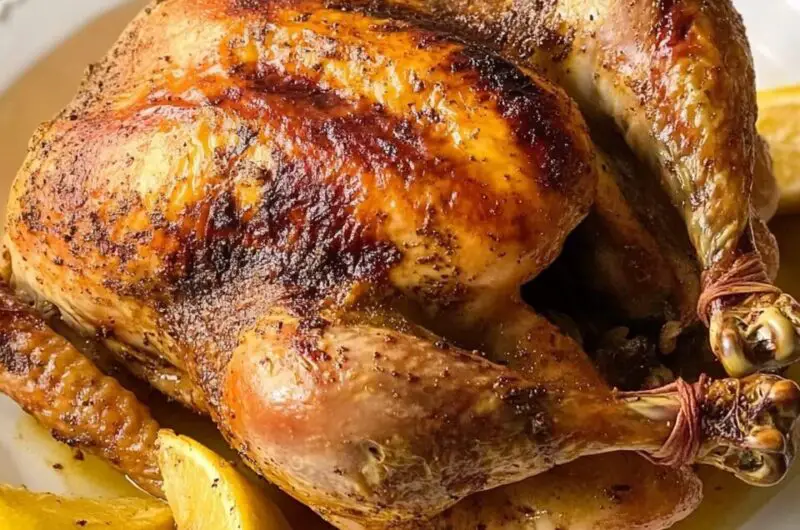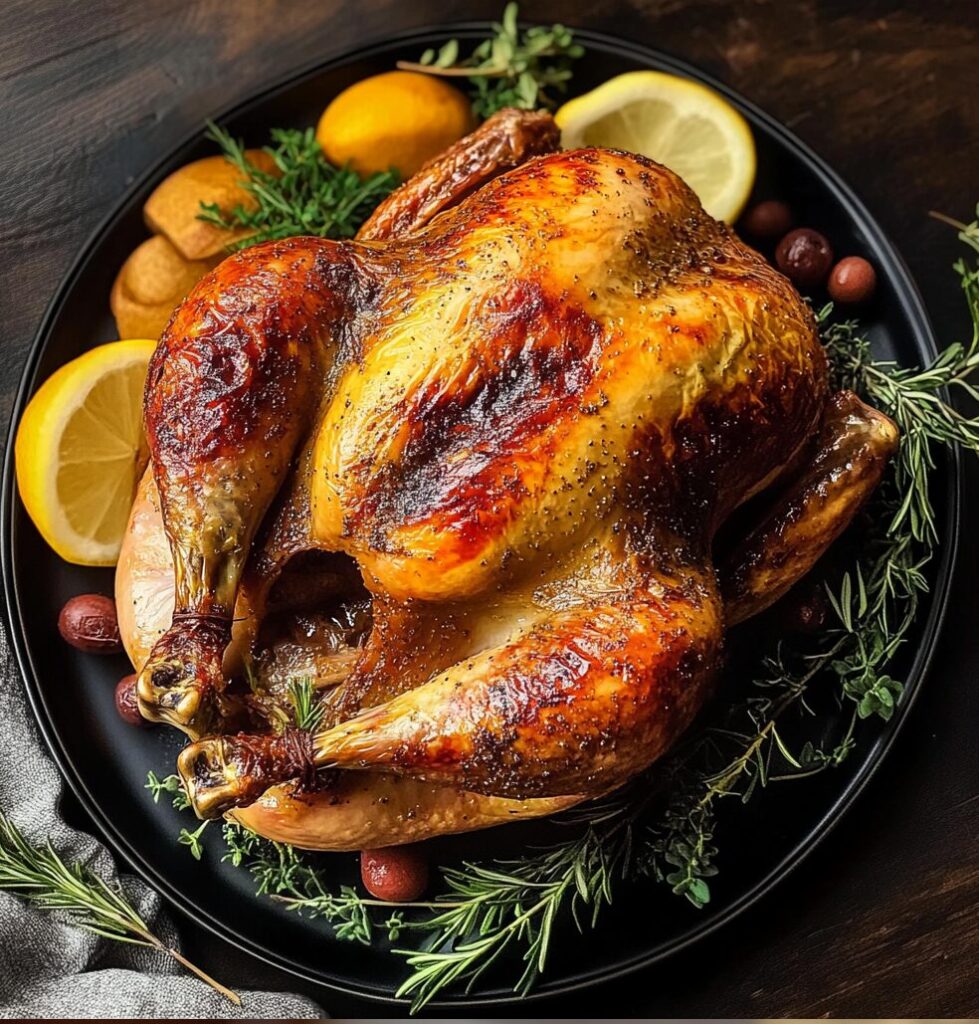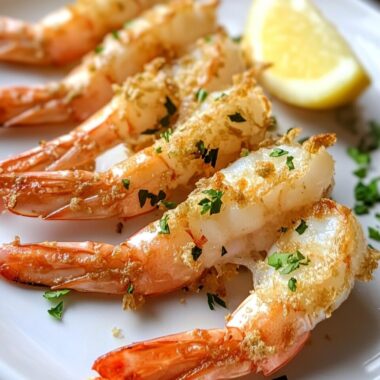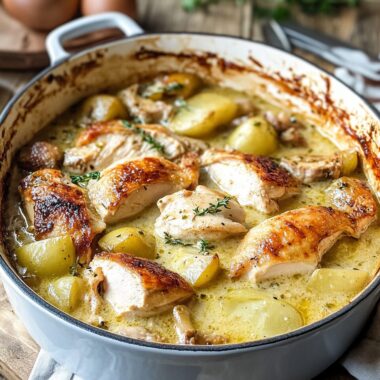Full Recipe:
Ingredients:
- 1 whole fryer chicken, fully thawed
- 1 tablespoon dried basil
- 1 tablespoon dried oregano
- 1 teaspoon paprika (smoked or regular)
- 1/2 teaspoon white pepper (or black pepper)
- 1/4 cup salted butter, softened
- 1 sprig fresh rosemary
- Salt to taste
Directions:
- Preheat your oven to 375°F (190°C). Prepare a roasting pan or baking sheet with a wire rack.
- Pat the chicken dry with paper towels, removing any excess moisture for a crispier skin.
- Gently separate the skin from the chicken breast, being careful not to tear it.
- In a small bowl, mix together the basil, oregano, paprika, white pepper, and a generous amount of salt.
- Rub the softened butter under the skin, massaging it into the meat for maximum moisture.
- Sprinkle the herb mixture evenly over the chicken, rubbing it on the skin and inside the cavity.
- Place the fresh rosemary sprig in the chicken cavity.
- Place the chicken on the prepared rack and roast for approximately 1 hour and 20 minutes, or until the internal temperature reaches 165°F (74°C).
- Remove the chicken from the oven and let it rest for 10 minutes before carving and serving.
Prep Time: 15 minutes | Cooking Time: 80 minutes | Total Time: 95 minutes
Kcal: 440 kcal | Servings: 4-6 servings
A Staple for Every Home Cook
Few dishes capture the essence of home cooking quite like a perfectly roasted chicken. It’s a meal that has withstood the test of time, gracing tables across various cultures and geographies for centuries. The allure of roast chicken lies not only in its simplicity but also in the satisfying blend of flavors, textures, and aromas it brings to the table. A crispy, golden-brown exterior envelops succulent, flavorful meat beneath, creating a satisfying contrast in every bite.
Choosing the Right Chicken
A well-roasted chicken begins with selecting a quality bird. Opting for a whole fryer chicken with good marbling will yield a more flavorful and juicy roast. Freshness is key, as well as ensuring the chicken is thoroughly thawed. The natural flavors of a good-quality chicken can elevate a simple recipe to gourmet levels with minimal added ingredients. Some cooks prefer organic or free-range chickens, noting that they tend to have a richer, more robust flavor. Choosing the right size is also important; smaller birds often yield more tender meat, while larger birds work well when feeding a crowd.
The Power of Seasoning
Aromatic herbs and spices are essential in creating a roast chicken that is both flavorful and memorable. This recipe calls for dried basil, oregano, and rosemary, with paprika for a touch of warmth and depth of color. Each ingredient contributes to the dish in its way. Basil and oregano add a hint of sweetness and a mild, herbaceous aroma that complements the chicken’s natural flavor. Paprika, particularly smoked paprika if available, adds a layer of earthy, slightly smoky flavor and helps achieve that rich, appealing color.
Herbs aren’t limited to the exterior; infusing the inside cavity of the bird with fresh rosemary sprigs or even garlic cloves can add layers of flavor that permeate the entire chicken. This method of seasoning ensures that every bite is flavorful without overwhelming the dish’s simplicity. For those who prefer fresh herbs, it’s worth noting that fresh options like basil, thyme, and sage can be swapped in, but use three times the amount for the same potency as dried herbs.
The Butter Rub: Secret to Crispy Skin and Juicy Meat
Butter, or even olive oil, is a key player in creating that coveted golden-brown skin and juicy meat. When rubbed under the skin, butter acts as both a flavoring agent and a basting liquid during the cooking process. As the butter melts in the oven, it bastes the meat, keeping it moist and infusing it with the herb blend. The fat in butter also contributes to a crispy skin, which is one of the most beloved elements of a well-roasted chicken. Olive oil works similarly, although it yields a slightly different flavor profile with a hint of fruitiness and a lighter crisp.
Roasting Methods: Pan Choices and Their Impact
While it may seem trivial, the type of roasting pan you use can impact the texture of your roast chicken. A traditional roasting pan with high sides traps moisture and keeps the bird juicy, while a baking sheet with a wire rack allows for maximum air circulation around the chicken, resulting in a crisper skin. Cast iron skillets are another excellent choice for their heat retention, which ensures even cooking, but they can be heavy and require careful maintenance. Dutch ovens are ideal for trapping moisture, producing a deeply juicy roast chicken, though they may prevent the skin from becoming as crispy as more open methods.
Ultimately, the choice depends on your personal preference—whether you prioritize juiciness or a crispy skin—and the equipment you have on hand. Seasoned home cooks often have a preferred method, but experimenting with various pans can yield exciting results and slight nuances in flavor and texture.
To Baste or Not to Baste?
Basting, or brushing the chicken with its juices or additional butter periodically, is a common technique believed to keep the meat juicy and flavorful. However, there’s a trade-off. Opening the oven door during roasting allows heat to escape, which can lead to longer cooking times and uneven temperature, which are not ideal for consistent roasting. Many modern cooks prefer not to baste, relying instead on the butter rubbed under the skin to self-baste as it melts and cooks. If you choose to baste, do so sparingly and quickly to avoid losing oven heat. For a safer approach, leave the chicken untouched while it roasts, letting the oven do its work undisturbed.
Achieving the Perfect Temperature
One of the essential elements of roasting chicken to perfection is achieving the correct internal temperature. For safety and flavor, the chicken should reach an internal temperature of 165°F (74°C) in the thickest part of the breast. Using a meat thermometer is highly recommended as it provides an accurate reading and removes any guesswork. This is particularly important because undercooking can pose health risks, while overcooking results in a dry, tough chicken.
Once the chicken reaches the desired temperature, removing it from the oven and letting it rest for about 10 minutes allows the juices to redistribute throughout the meat. This resting period is crucial for achieving tender, moist chicken rather than allowing juices to run out when the chicken is carved immediately.
Carving Tips for a Beautiful Presentation
Carving a roasted chicken may seem daunting, but with a few simple steps, it can be an easy and even elegant process. Begin by placing the bird on a stable cutting board. Start by slicing along the breastbone, removing the breast in one piece for a cleaner presentation. Following the natural joints, carve out the wings, thighs, and drumsticks, arranging each part neatly on a serving platter. This process allows for an organized and visually appealing display, making the dish even more enticing at the dinner table. For added presentation, you might garnish with fresh herbs or lemon slices for a pop of color and fragrance.
Storing and Reheating Leftovers
Leftover roast chicken is not only versatile but also incredibly convenient for quick meals throughout the week. To maintain its quality, store the chicken in an airtight container and refrigerate it within two hours of cooking. It can last in the refrigerator for up to four days. If you plan to freeze it, wrap it securely to prevent freezer burn, and thaw it in the refrigerator before reheating. When reheating, using an oven set to 325°F (163°C) will help retain its moisture without drying it out.
Pairing Suggestions and Serving Ideas
Roast chicken is a versatile dish that pairs well with numerous side options. Classic choices include mashed potatoes, roasted vegetables, or a fresh salad. For a more indulgent meal, consider serving it with buttery mashed potatoes, creamy risotto, or even a homemade gravy made from the pan drippings. Adding a side of fresh bread, like baguettes or dinner rolls, can also elevate the meal, allowing you to soak up any flavorful juices from the plate.
For a lighter meal, pair the roast chicken with a vibrant green salad or a side of roasted root vegetables. These options not only bring a splash of color to the table but also add nutritional variety and balance out the richness of the chicken.
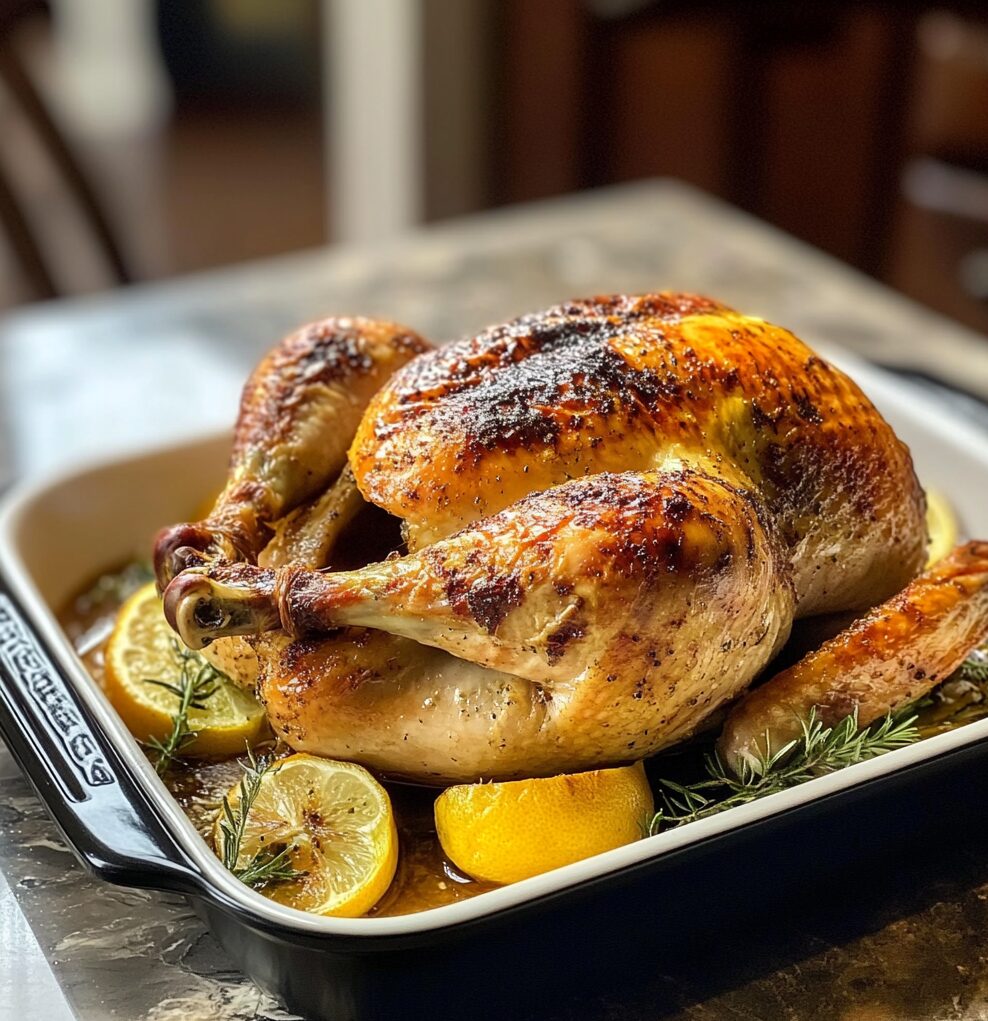
Conclusion:
A perfectly roasted chicken is more than just a meal; it’s a comforting experience and a culinary tradition shared by generations. This simple yet satisfying recipe allows for personalization, from the choice of herbs to the method of roasting. Whether it’s a holiday feast or a casual family dinner, roast chicken never fails to impress with its blend of crispy skin, juicy meat, and aromatic herbs.
By mastering this dish, home cooks can create a reliable go-to meal that’s not only easy to prepare but also endlessly adaptable to taste preferences and dietary needs. With the right techniques and a few quality ingredients, roast chicken transforms from a basic dish to a centerpiece worth savoring. The beauty of this classic lies in its simplicity, inviting even novice cooks to enjoy the rewarding experience of a home-cooked meal. So, the next time you seek comfort on a plate, remember the timeless appeal of a well-roasted chicken and savor every delicious bite.
Print
Perfect Roast Chicken
- Total Time: 1 hour 35 minutes
Description
This Perfect Roast Chicken recipe embodies the essence of home-cooked comfort. With a golden-brown, crispy skin and tender, juicy meat seasoned with fresh rosemary, basil, and oregano, it’s the kind of dish that makes you feel at home with every bite. The butter and herb rub enhances the chicken’s natural flavors while keeping it incredibly moist. Ideal for family gatherings, holiday feasts, or a cozy dinner, this roast chicken is a timeless meal that’s both simple to prepare and guaranteed to impress. Whether served with roasted vegetables, mashed potatoes, or a light salad, this dish brings warmth and satisfaction to any table.
Ingredients
- 1 whole fryer chicken, fully thawed
- 1 tablespoon dried basil
- 1 tablespoon dried oregano
- 1 teaspoon paprika (smoked or regular)
- 1/2 teaspoon white pepper (or black pepper)
- 1/4 cup salted butter, softened
- 1 sprig fresh rosemary
- Salt to taste
Instructions
- Preheat your oven to 375°F (190°C). Prepare a roasting pan or baking sheet with a wire rack.
- Pat the chicken dry with paper towels, removing any excess moisture for a crispier skin.
- Gently separate the skin from the chicken breast, being careful not to tear it.
- In a small bowl, mix together the basil, oregano, paprika, white pepper, and a generous amount of salt.
- Rub the softened butter under the skin, massaging it into the meat for maximum moisture.
- Sprinkle the herb mixture evenly over the chicken, rubbing it on the skin and inside the cavity.
- Place the fresh rosemary sprig in the chicken cavity.
- Place the chicken on the prepared rack and roast for approximately 1 hour and 20 minutes, or until the internal temperature reaches 165°F (74°C).
- Remove the chicken from the oven and let it rest for 10 minutes before carving and serving.
- Prep Time: 15 minutes
- Cook Time: 80 minutes

